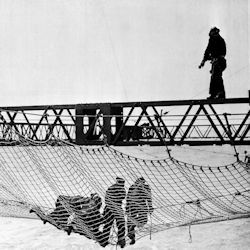21.F.05 Existing parapet walls.
In order for parapet walls to be considered adequate fall protection systems, they must have a height of 42 in +/- 3 in (1 m +/- 7.6 cm) unless it is an EXISTING parapet walls with a height of less than 42 in (1 m). If so, the EXISTING parapet wall may be used as a compliant fall protection system if the vertical height is a minimum of 30 in (76 cm) or more plus width that equals to 48 in (1.2 m). > See Figure 21-2.
21.G Covers.
21.G.01 Install covers on any hole 2 in (5.1 cm) or more in its least dimension on walking/working surfaces such as floors, roofs or other openings.
21.G.02 Covers must be capable of supporting, without failure, at least twice the weight of the worker, equipment and material combined.
21.G.03 Covers must be secured when installed, clearly marked with the word "HOLE", "COVER" or "Danger, Roof Opening-Do Not Remove" or color-coded or equivalent methods (e.g., red or orange "X"). Workers must be made aware of the meaning for color coding and equivalent methods.
21.H Safety Net Systems for Fall Protection.
Debris nets are addressed in Section 14.E Housekeeping.
21.H.01 Safety nets must be installed as close under the work surfaces as practical but in no case more than 30 ft (9.1 m) below such work surface. Nets must be hung with sufficient clearance to prevent contact with the surfaces or structures below. Such clearance must be determined by impact load testing. When nets are used on bridges, multi-story buildings or structures, the potential fall area from the walking/working surface to the net must be unobstructed.
- The maximum size of the mesh openings must not exceed 36 in2 (230 cm2), nor be longer than 6 in (15 cm) on any side.
- The border rope or webbing must have a minimum breaking strength of 5,000 lb (22.2 kN).
21.H.02 Nets must extend outward from the outermost projection of the work surface as shown in Table 21-1.
| Vertical Distance from Working Level to Horizontal Plane of Net |
Minimum Required Horizontal Distance of Outer Edge of Net from Edge of Working Surface |
|
|---|---|---|
| Up to 5 ft (up to 1.5 m) |
8 ft (2.5 m) |
|
| 5 ft up to 10 ft (1.5 m up to 3.1 m) (up to 1.5 m) |
10 ft (3.1 m) |
|
| More than ft (more than to 3.1 m) |
13 ft (4 m) |
|
21.H.03 Operations requiring safety net protection must not be undertaken until the net(s) is in place and has either been tested without failure per a. and b. below, or complies with c. below.
- Safety nets and safety net installations must be tested in the suspended position immediately after installation under the supervision of QP and in the presence of the GDA and before being used as a fall protection system; whenever relocated, after major repair; and when left at one location, at not more than 6 month intervals.
- The test must consist of dropping into the net a 400 lb (180 kg) bag of sand, not more than 30 in+/- 2 in (76.2 cm +/- 5 cm) in diameter, at least 42 in (106.6 cm) above the highest working/walking surface at which workers are exposed to fall hazards. Means must be taken to ensure the weight can be safely retrieved after the test is conducted.
- If a QP can demonstrate in writing that it is unreasonable to perform the drop-test, the QP must certify in writing that the net and installation (to include anchorages) is in compliance with all requirements for acceptance by the GDA. The certification must include an identification of the net and net installation, the date that it was determined, and the signature of the QP making the determination and certification. The certification must remain at the job-site.
21.H.04 Shackles and hooks used in safety net installations must be made of forged steel.
21.H.05 When used with safety nets, debris nets must be secured on top of the safety net but must not compromise the design, construction, or performance of the safety nets.
21.H.06 Materials, scrap pieces, equipment, and tools that have fallen into the safety net must be removed as soon as possible and at least before the next work shift. Safety nets must be protected from sparks and hot slag resulting from welding and cutting operations.
21.H.07 Inspection of safety nets.
- Safety nets must be inspected by a CP in accordance with the manufacturer's instructions and recommendations.
- Inspections must be conducted immediately after installation, at least weekly thereafter, and following any alteration, repair, or any occurrence that could affect the integrity of the net system. Inspections must be documented.
- If any welding or cutting operations occur above the net(s), noncombustible barriers must be provided. The frequency of inspections must be increased in proportion to the potential for damage to the nets.
- Defective nets must not be used. Defective components must be removed from service and replaced.
Knowledge Check Choose the best answer for the question.
21-7. How close must safety nets be installed below a work surfaces?
You forgot to answer the question!


